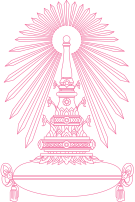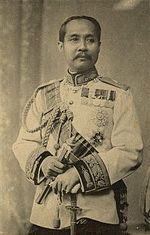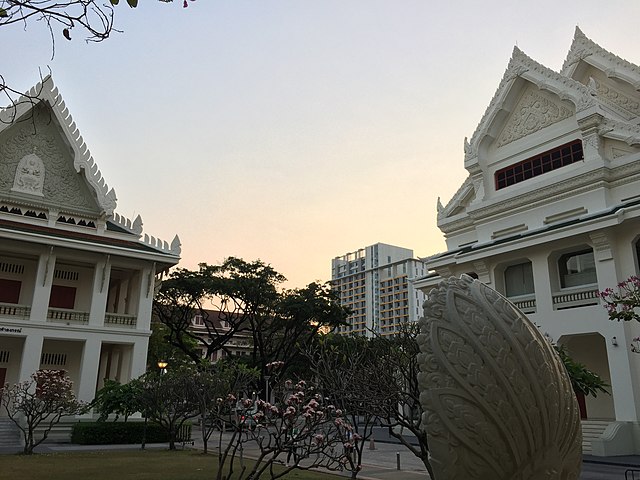Loading AI tools
University in Bangkok, Thailand From Wikipedia, the free encyclopedia
Chulalongkorn University (CU, Thai: จุฬาลงกรณ์มหาวิทยาลัย, RTGS: Chulalongkon Mahawitthayalai), nicknamed Chula (Thai: จุฬาฯ), is a public autonomous research university in Bangkok, Thailand. The university was originally founded during King Chulalongkorn's reign as a school for training royal pages and civil servants in 1899 (B.E. 2442) at the Grand Palace. It was later established as a national university in 1917, making it the oldest institute of higher education in Thailand.[3]
This article needs additional citations for verification. (August 2023) |
จุฬาลงกรณ์มหาวิทยาลัย | |
 Phra Kiao, Chulalongkorn University Seal | |
Former names |
|
|---|---|
| Motto |
|
Motto in English |
|
| Type | Autonomous public university |
| Established | 26 March 1917 |
| Founder | King Vajiravudh |
Academic affiliation | ASAIHL, AUN, APRU, Washington University in St. Louis McDonnell International Scholars Academy[1] |
| Budget | 5,535 million baht (FY2019) |
| President | Wilert Puriwat |
| Students | 37,626[2] |
| Undergraduates | 26,202[2] |
| Postgraduates | 8,029[2] |
| 2,627[2] | |
| Location | , Thailand 13.738359°N 100.532097°E |
| Campus | Downtown 2.0944 km2 (0.8087 sq mi) |
| Anthem | "Maha Chulalongkorn" ("Great Chulalongkorn") |
| Colours | Pink |
| Mascot | Samanea saman |
| Website | chula.ac.th chula.ac.th/en |
 | |
During the reign of Chulalongkorn's son, King Vajiravudh, the Royal Pages School became the Civil Service College of King Chulalongkorn. The Rockefeller Foundation[4] was instrumental in helping the college form its academic foundation.[5][6] On 26 March 1917, King Vajiravudh renamed the college "Chulalongkorn University".[7]
Chulalongkorn University is one of the National Research Universities and supported by the Office of Nation Education Standards and Quality Assessment of Thailand. Moreover, CU is the only Thai university which is a member of Association of Pacific Rim Universities (APRU).[8]

CU is composed of nineteen faculties, a School of Agriculture, three colleges, ten institutes and two other schools. Its campus occupies a vast area in downtown Bangkok. Graduates customarily receive their diplomas from the King of Thailand, a tradition begun by King Prajadhipok.


King Chulalongkorn's reforms, aimed at transforming Thailand into a modern state, demanded trained officials specialized in various fields. In 1899, the King founded the "Civil Service Training School"[9] near the north gate of the Grand Palace. Those who graduated from the school would become royal pages. As royal pages, they learned how to manage organizations by working closely with the king, which was a traditional way to enter the Siamese bureaucracy. After serving as royal pages, they would then serve in the Ministry of Interior or other government ministries.
On 1 April 1902, the King renamed the school. It became the "Royal Pages School" (Thai: โรงเรียนมหาดเล็ก).[10] On 1 January 1911, King Vajiravudh changed the name to "Civil Service College of King Chulalongkorn" (Thai: โรงเรียนข้าราชการพลเรือนของพระบาทสมเด็จพระจุลจอมเกล้าเจ้าอยู่หัว) as a memorial to his father and moved the school to Windsor Palace in the Pathumwan District.[11]
The King subsidized the construction of a university campus and organized various schools around the city into Chulalongkorn. The college offered eight majors taught by five schools including;

King Rama VI realized that education should be provided not only to bureaucrats, but to all people. On 26 March 1917, the college was upgraded to "Chulalongkorn University" (Thai: จุฬาลงกรณ์มหาวิทยาลัย),[12] and the schools were transformed into four faculties: Faculty of Arts and Sciences, Faculty of Public Administration, Faculty of Engineering, and Faculty of Medicine.
The Rockefeller Foundation reorganized the curriculum of the Faculty of Medicine. In 1923, the Faculty of Medicine became the first faculty to accept secondary school (Mattayom) graduates. The remaining faculties then followed suit. After the 1932 Revolution, the People's Party wanted legal and political studies to be independent of "royalists" so they moved the Faculty of Law and Political Science to the new Thammasat University in 1933.
In 1938, Chulalongkorn University's Preparatory School was founded to provide pre-collegiate education to students. Those who managed to enter the university had to spend two years in the Preparatory School before going on to the Faculty of Arts and Sciences. The Preparatory School, however, ceased to be a university-owned preparatory school in 1947 and became the independent Triam Udom Suksa School. Later, the university established Chulalongkorn University Demonstration School (CUD) as a laboratory school for primary and secondary education for the Faculty of Education.

Since the establishment of the Royal Pages School, the former name of the university, King Chulalongkorn authorized the use of his personal emblem as a school emblem.[13] The emblem is called Phra Kiao, a Thai coronet, royal headgear for young princes and princesses. As the school was transformed into the university, the King authorized the use of phra kiao. Today, phra kiao appears not only in formal letters and transcripts, but also on souvenirs made by the university as well as student uniforms.
Undergraduates are required to wear a uniform when studying, taking examinations, or contacting the university in person. Male graduate students wear a collared or polo shirt and dark trousers. Women wear a plain blouse with long skirt.
Originally, the university uniform was adapted from a uniform worn by Chulalongkorn's heirs.[14] The uniform was later updated, but the original is reserved as a formal uniform. The formal uniform is usually worn by student leaders and graduates.
Today, the ordinary uniform for male undergraduate students consists of a plain white shirt with long or short sleeves and black (or dark blue) trousers. Wearing a dark blue necktie with colored phra kiao engraved on its front is mandatory for first-year students but optional for higher years. However, a black tie with a silver phra kiao pin is usually used by upperclass student in some faculties. Female students are required to wear a short-sleeved blouse with a fold along the spine. The buttons must be made of metal, and a small phra kiao emblem must be pinned on the right breast. A dark blue or black pleated skirt with any black, white, or brown shoes are worn. For female first-year students, white leather shoes are mandatory.[15] Chulalongkorn University's uniforms have long been the template of many uniforms used in other universities in Thailand.
The academic dress of Chulalongkorn University is based on ceremonial attire called khrui, a gown made from very fine mesh. The robe was originally reserved for pre-ordination monks, ministers and royal family members. Like dresses worn in the United Kingdom, the robe is open-fronted and calf-length. Cap and hood, however, are omitted. The gown is faced and lined with a felt strip dyed according to the status of the wearer and decorated with gold ribbons. The elbow and wrist portion of the gown is also wrapped with the same felt strip.
Bachelor's and master's gown is faced and bordered with a black felt strip, while a doctor's gown uses a scarlet felt strip. This colour scheme is similar to one used at the University of Oxford: Black for bachelors and masters (and doctors in undress); Scarlet for doctors (in full-dress).[16] The cord (bachelor) or ribbon (master and doctor) dyed with the faculty colour is attached to the centre of the felt strip longitudinally.[17] Officers' (lecturers, university council members, vice-chancellor and chancellor) gown is faced with a pink strip and centred with a gold thread, regardless of the faculty. The specially designed gown with a yellow facing is reserved for the king of Thailand, who is also Visitor to the University.[18]
Vajiravudh authorized the university to use the traditional Thai gown instead of the western one,[19] but the regulation on this matter was enacted in 1930 by Prajadhipok.[20]

Rain trees are common on the university campus. They are associated with the cycle of student life. Fresh green leaves at beginning of the term represent the freshmen's naivete. As the tree produces slimy pods and sheds leaves, the ground beneath it becomes slippery, thus alerting students to prepare for examinations. If they walk carefully, they will not slip (pass examinations). If they walk heedlessly, they will slip and fall (fail examinations).[21]
From 1937–1957, many rain trees were cut down to free space for new buildings. King Bhumibol Adulyadej noticed the dramatic decrease in the number of rain trees. On 15 January 1962, he brought five trees from Hua Hin and planted them in front of the university auditorium, proclaiming: "...I give these five trees as an eternal memorial." (Thai: จึงขอฝากต้นไม้ไว้ห้าต้นให้เป็นเครื่องเตือนใจตลอดกาล).




Chulalongkorn University consists of 19 faculties, three colleges, one school and many institutes which function as teaching and research units.[22][23]
In 1917, the university had four faculties: Arts and Sciences, Public Administration, Engineering, and Medicine. The Faculty of Law was established in 1933 as part of the Faculty of Law and Political Science.[24] From the 1930s to the 1950s it expanded to various fields including Pharmacy (1934), Veterinary Science (1935), Architecture (1939), Dentistry (1940), and Commerce and Accountancy (1943). In 1943, the regency government under General Phibun separated the Faculty of Medicine, Dentistry, Pharmacy, and Veterinary Science to become the University of Medical Sciences, now Mahidol University. In 1948, the Faculty of Political Science was re-established. The Faculty of Education was established in 1957 from the School of Teacher Training at Baan Somdet Chao Phraya (Thai: โรงเรียนฝึกหัดครู บ้านสมเด็จเจ้าพระยา).[25] In 1967, the Faculty of Veterinary Science was returned from Kasetsart University and the Faculty of Medicine at Chulalongkorn Hospital was moved from University of Medical Sciences to Chulalongkorn University. In 1972, the Faculty of Dentistry and Faculty of Pharmacy were reinstated.
The Office of the Commission on Agricultural Resource Education (OCARE) was established in 2009.[26] It is not an administrative office, but a school in which teaching and research are carried out. It admits students from two groups: one from northern Thai provinces (Nan, Phayao, Phrae, Uttaradit) and another from the rest of country. It was upgraded to the School of Agricultural Resources with full degree-granting power on 5 March 2014.[23] In 2014 it became the School of Agriculture, Chulalongkorn University (SAR).
In 2019, aiming to address global industry changes and demand for relevant education, Chulalongkorn University launched Chulalongkorn School of Integrated Innovation (ScII) to offer the first in Asia interdisciplinary undergraduate degree in both arts and science - Bachelor of Arts and Science in Integrated Innovation (BAScii).[27]


CU's international programs offers 99 international programs, including 17 Bachelor, 48 Master and 34 Doctoral programs. Admissions for international students are based on the guidelines issued by the Council of University Presidents of Thailand.
Bachelor's Degrees:
Chulalongkorn University has research organizations in many fields of study.
QS World University Rankings by Subject 2024: Chula ranked number one in Thailand in 32 disciplines[48]
| World rank | Subject |
|---|---|
| 51 – 100 |
|
| 101 – 150 |
|
| 151 – 200 |
|
| 201 – 250 |
|
| 251 – 300 |
|
| 301 – 400 |
|

The university campus occupies an area of 637 rai (101.9 ha; 252 acres) in the downtown Pathum Wan District. It accounts for just over half of the 1,153 rai (184.5 ha; 456 acres) of land owned by the university, the rest of which is commercially developed by the university's Property Management Office or used by other institutions.
The west side of Chula's campus is the site of this innovative park. It has gradually sloping portions.[49] Its 28 rai expanse contains a water retention pond with a capacity of 3.8 million liters and a rain garden. Both help to ameliorate Bangkok's seasonal flooding. It was built to commemorate Chula's 100th anniversary in 2017.[50]
Chulalongkorn University International House (CU iHouse)[51] is a 26-storey, 846-unit, on campus residence for international students and lecturers. Rooms come fully furnished with air conditioning, modern conveniences, 24-hour security and safety systems. The residence is included in the university's shuttle bus services.
The university has bestowed honorary degrees on heads of state and other international dignitaries, including two U.S. presidents:
Chulalongkorn University student traditions include:
The university is host to 40 student clubs, including the Buddhism and Traditions Club, the Religious Studies Club, the Mind Study Club, and the Thai Classical Music Club. Chulalongkorn also has a Morals Network, which actively campaigns to protect student activities from damaging the university's reputation. The university's Cheer Club annually organizes the Chula-Thammasat traditional football match.
The university RoboCup team, Plasma‐Z, got several prizes from the robotics competition as follow.[58]
Moreover, another university Robocup team, Plasma-RX has participated in Rescue robot league at World RoboCup 2008, Suzhou, China, and won the first prize and the best-in-class in mobility award.[59][60]
Seamless Wikipedia browsing. On steroids.
Every time you click a link to Wikipedia, Wiktionary or Wikiquote in your browser's search results, it will show the modern Wikiwand interface.
Wikiwand extension is a five stars, simple, with minimum permission required to keep your browsing private, safe and transparent.